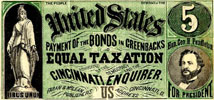Historical Background
Throughout the 1800s, third parties had an influence on politics, and frequently showed their strength on the national level by winning electoral votes. This practice declined somewhat in the 1870s. However, in the last quarter of the century, pushed by the populist movement, third parties seemed on the brink of creating revolutionary change in the United States.

The Greenback Party, which lasted from roughly 1876 to 1884 had an early and important influence on this revival. Party members supported an expansion of U.S. currency as paper money in order to help the farmers who had been suffering economically. The party was also strongly anti-monopoly, and they viewed banks as their opposition. In 1878, they received 13.8% of the national vote. These Greenbackers formed "the basis of subsequent populist mobilization" (Taggart 31). Many of the ideas and the key people of the Greenback Party would become important in the rise of the People's Party.
The People's Party formed in 1891. On February 22, 1892, members of the party met in St. Louis and adopted their platform. The party advocated an increased money supply, "unlimited coinage of both gold and silver," government control of the railroads, and improved labor conditions (Kazin 29, 38). This platform portrayed the typical ideals of populism. Populists drew their ideology from "the beliefs and values of antebellum artisans and farmers," and felt that those who work and produce goods deserve to reap the rewards of this work, or, more succinctly, "labor creates value" (McMath 51). The People's Party saw corruption at the top of the power structure, and was essentially anti-elitism and anti-corporation (Kazin 30). As we shall see, this anti-corporate nature helped to eventually kill off the People's Party.

Early on, the People's Party looked strong. In 1892, James Weaver, the party's nominee for president, took over 1 million popular votes (8.5%), and he won Colorado, Idaho, Nevada, North Dakota, and Kansas. Kazin points out, "In no national election from 1872 to 1880 did the combined votes of all alternative parties top 4% of the total. The People's Party offered the best and perhaps the last chance to convert antimonopoly sentiment into a winning strategy" (37). Furthermore, the populists gained control of the Kansas legislature that year (Hofstadter 101). The party appeared to be gaining support among the public and the future looked good. In 1894 People's Party candidates captured seven seats in the House of Representatives and six in the U.S. Senate. They also took hundreds of state legislator positions (Kazin 43). Futhermore, the Democratic Party was becoming increasingly fragmented and unstable. Taggart writes, "The Populists therefore had the potential to realign the party system around them" (30-31).
The People's Party seemed strong, and on the verge of success. However, they failed terribly in 1896, and then ceased to exist. They faced both external and internal problems, and ultimately were doomed.
| Home | Introduction | Background | Major Party Incorporations | Internal Problems | Aftermath | Annotated Bibliography |